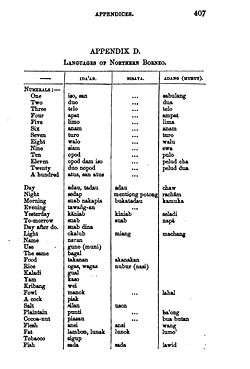Lun Bawang language
| Lun Bawang | |
|---|---|
| Lundayeh | |
| Southern Murut | |
|
| |
| Native to | Malaysia, Brunei, Indonesia |
| Region | Sarawak, Sabah, Temburong, North Kalimantan |
Native speakers | (48,000 (2007 in Indonesia; no date Malaysia) plus 6,000 Putoh cited 1981)[1] |
| Dialects |
|
| Language codes | |
| ISO 639-3 |
lnd – inclusive codeIndividual code: put – Putoh |
| Glottolog |
lund1271[2] |
|
Geographical distribution of Lun Bawang/Lundayeh speakers | |
The language spoken by the Lun Bawangs (or Lundayeh) belongs to the Malayo-Polynesian family. The first published material written fully in the Lun Bawang language is a translation of the Bible in 1982, which is called Bala Luk Do.[3] A Lun Bawang–English dictionary was constructed in 1969 by the University of Washington.[4] A dialect of the Lun Bawang language, Kemaloh Lundayeh, was recently (2006) compiled into a bilingual dictionary of Lundayeh language and English.[5] The Lun Bawang language is mainly an oral language. There is very little printed written material in this language that was not written by missionaries or linguists. The oral culture of the Lun Bawang people is changing though, with the accessibility of the Internet and Facebook. "Putoh" is an alternate name in East Kalimantan.[6]
Examples
Lord's Prayer (Our Father)
O Taman kai luk bang surga, dó ngadan-Mu uen ngerayeh. Idi imet-Mu uen ngaching, idi luk pian-Mu mangun bang taná kudeng bang surga. Maré nekai acho sini akan luk petap. Idi maré dó ratnan amung-amung baleh kai mepad kudeng kai pangeh nemaré ddó ratnan amung-amung baleh dulun. Idi aleg nguit nekai amé bang luk nutun, iamdó muit nekai ratnan luk dat. Amen. Ngacheku Iko luk kuan imet idi lalud idi rayeh maching ruked-ruked peh. Amen.
- Translation:
Our Father, who art in heaven, hallowed be thy name. Thy kingdom come, Thy will be done on earth as it is in heaven. Give us this day our daily bread, and forgive us our sins, as we forgive those who sin against us. Do not lead us into temptation, but deliver us from evil. Amen. For the kingdom, the power, and the glory, are Yours now and forever. Amen.
Phonology
There are 6 vowels, 18 consonants and 5 diphthongs in the Lun Bawang language.[7]
| Bilabial | Dental | Alveolar | Post- Alveolar |
Palatal | Velar | Glottal | ||||||||||||
|---|---|---|---|---|---|---|---|---|---|---|---|---|---|---|---|---|---|---|
| Nasal | m /m/ | n /n/ | ng /ŋ/ | |||||||||||||||
| Plosive | p /p/ | b /b/ | bp /b͡p/ | t /t̪/ | d /d/ | k /k/ | g /ɡ/ | gk /ɡ͡k/ | /ʔ/ | |||||||||
| Affricate | c /d͡tʃ/[8] | |||||||||||||||||
| Fricative | s /s/ | /ɣ/ | h /h/ | |||||||||||||||
| Approximant | l /l/ | r /r/ | y /j/ | w /w/ | ||||||||||||||
According to Blust (2006), Lun Dayeh has a series of mixed-voiced stops, [b͡p, d͡tʃ, ɡ͡k] similar to those of Kelabit, but does not have a simple [tʃ].
| Height | Front | Central | Back |
|---|---|---|---|
| Close | i /i/ | u /u/ | |
| Mid | e /e, ɛ/ | e /ə/ | o /o, ɔ/ |
| Open | a /ɡ/ |
| Orthography | IPA |
|---|---|
| ai | /ai̯/ |
| au | /au̯/ |
| ia | /i̯a/ |
| ou | /ou̯/ |
| ui, oi | /ɔʏ̯/ |
References
- ↑ Lun Bawang at Ethnologue (18th ed., 2015)
Putoh at Ethnologue (18th ed., 2015) - ↑ Hammarström, Harald; Forkel, Robert; Haspelmath, Martin; Bank, Sebastian, eds. (2016). "Lundayeh". Glottolog 2.7. Jena: Max Planck Institute for the Science of Human History.
- ↑ Peter Martin, ed. (2008), Educational Discourses and Literacy in Brunei Darussalam (PDF), 11(2), University of East London, London, UK: The International Journal of Bilingual Education and Bilingualism, p. 207, doi:10.2167/beb494.0, ISSN 1367-0050, Unknown ID 1367-0050/08/02 206-20, retrieved 2010-09-25
- ↑ James L. Deegan, ed. (2006), Report on Anthropological Field Work Among the Lun Bawang (Murut) people of Sarawak (PDF), 3, Borneo Research Bulletin, p. 14, retrieved 2010-09-25
- ↑ Ricky Ganang, Jay Crain and Vicki Pearson-Rounds, ed. (2006), Kemaloh Lundayeh - English Dictionary (PDF), Sacramento, USA: CSU Sacramento, retrieved 2010-09-25
- ↑
- ↑ Pelita Brunei - Sastera dan Budaya
- ↑ Robert Blust, 2006, "The Origin of the Kelabit Voiced Aspirates: A Historical Hypothesis Revisited", Oceanic Linguistics 45:311

